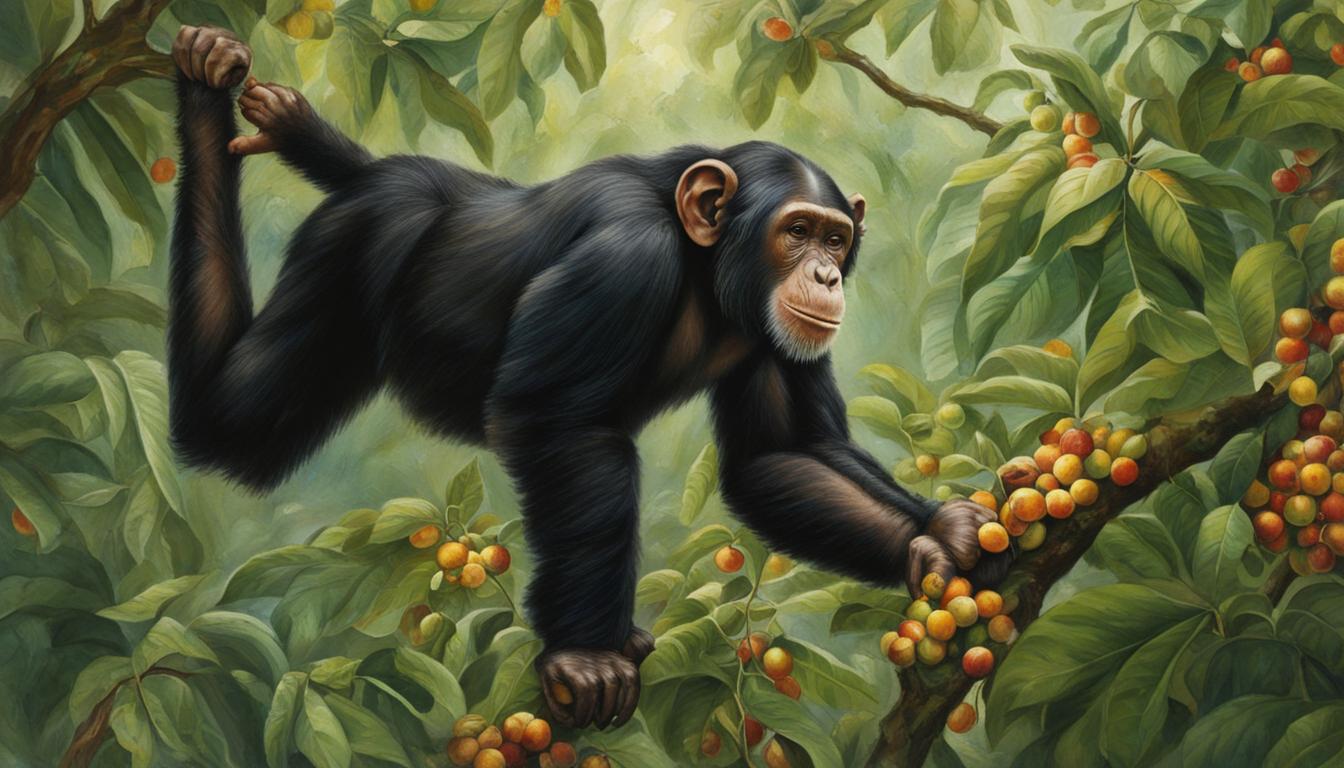Chimpanzees, fascinating creatures closely related to humans, have unique feeding behaviors and dietary requirements. Understanding their diet and foraging habits gives us insight into their natural behavior and nutritional needs.
As omnivores, chimpanzees have a varied diet that includes both plant and animal sources. While their primary food sources consist of fruits, seeds, nuts, leaves, flowers, and insects, their foraging techniques can be quite inventive. They are known to utilize tools and seek out medicinal and recreational food sources.
Chimpanzees exhibit a wide range of food preferences. They consume fruits such as figs, mangoes, bananas, watermelons, and apples, depending on the availability in their habitat. Nuts and seeds, particularly oil palm nuts, kola nuts, and panda nuts, provide them with essential proteins and fats. They also consume various types of vegetation, including leaves, flowers, tree bark, and seeds. Insects, especially ants and termites, make up a portion of their diet and serve as a valuable protein source.
Contrary to previous beliefs, chimpanzees have been observed hunting for and consuming meat, which constitutes a small percentage of their overall diet. They also exhibit social behavior by sharing food with other group members.
Additionally, chimpanzees have demonstrated a remarkable understanding of their environment, consuming palm wine, a mildly alcoholic beverage created from fermented raffia palm sugars. They have also been seen consuming certain medicinal plants that aid in parasite elimination and possess anti-malaria and antibacterial properties.
It is important to note that the specific dietary preferences and foraging techniques of chimpanzees can vary depending on their location and food availability. Their diverse diets ensure they obtain the necessary nutrients to maintain their health and well-being in their natural habitats.
What fruits do chimpanzees eat?
Chimpanzees have a diverse diet that includes a wide variety of fruits. Some of the fruits commonly consumed by chimpanzees include mangoes, bananas, watermelons, and apples. However, the specific fruit choices of chimpanzees can vary depending on the region in which they live and the availability of fruits during different seasons.
Fruits make up a significant portion of a chimpanzee’s diet and play a crucial role in meeting their nutritional needs. They are a rich source of energy and provide essential vitamins and minerals. Chimpanzees have developed a preference for certain types of fruits based on their taste and nutritional value.
| Fruits | Description |
|---|---|
| Mangoes | Sweet and juicy tropical fruits that provide a good source of vitamin C and dietary fiber. |
| Bananas | Highly nutritious fruits that are rich in potassium, vitamin B6, and dietary fiber. |
| Watermelons | Refreshing fruits with high water content, providing hydration and a good source of vitamins A and C. |
| Apples | Crunchy fruits that are a good source of fiber and vitamin C. |
These are just a few examples of the fruits that chimpanzees consume. Their diet may include other types of fruits based on availability and their individual preferences. The consumption of a variety of fruits ensures that chimpanzees receive a balanced and nutritious diet.
What nuts and seeds do chimpanzees eat?
Chimpanzees include nuts and seeds as part of their diverse diet. The most common type of nut they consume is the oil palm nut. They also enjoy eating kola nuts and panda nuts. These nuts have tough shells, which chimpanzees crack open using hard stones, showcasing their remarkable tool-using abilities. Nuts and seeds are an important source of protein and fats in their diet, providing them with essential nutrients to support their overall health.
Chimpanzees have adapted their foraging techniques to access and consume these nuts. Their ability to crack open the tough shells demonstrates their resourcefulness and ingenuity when it comes to obtaining food. By utilizing tools and applying the necessary force, they are able to access the nutritious contents within.
Here is a table showcasing the types of nuts and seeds that chimpanzees commonly consume:
| Nuts and Seeds |
|---|
| Oil palm nuts |
| Kola nuts |
| Panda nuts |
Chimpanzees rely on a variety of food sources to meet their dietary needs, and nuts and seeds play an important role in providing them with essential nutrients. By incorporating these items into their diet, they ensure a balanced and diverse intake of food.

What other vegetation do chimpanzees eat?
When fruit is scarce, chimpanzees turn to various types of vegetation to fulfill their dietary needs. While fruits are preferred, vegetation such as leaves, flowers, tree bark, and seeds provide additional nutrients and fiber to their diet.
Chimpanzees have a versatile palate and can adapt to different food sources based on availability. Their diet consists of a diverse range of plants, which allows them to obtain essential nutrients even when fruit is limited.
In addition to fruits, chimpanzees consume the following types of vegetation:
- Leaves: Chimpanzees eat a variety of leaves to supplement their diet. They may consume leaves from trees, shrubs, or other plants.
- Flowers: Certain flowers are also part of a chimpanzee’s diet. They may be attracted to the nectar or other components of the flowers.
- Tree bark: Chimpanzees may strip the bark off trees to access inner layers that may contain nutrients and fibers.
- Seeds: While seeds are primarily found in fruits, chimpanzees may also eat them directly from plants or other sources.
By incorporating vegetation into their diet, chimpanzees ensure they receive a well-rounded nutritional intake, even during periods of fruit scarcity.
What insects do chimpanzees eat?
Insects play a significant role in a wild chimpanzee’s diet, constituting approximately 4% of their overall food consumption. Chimpanzees have been observed foraging for insects, particularly ants and termites, which serve as an important source of protein for them.
One fascinating behavior documented by Dr. Jane Goodall in Gombe National Park is the use of tools by chimpanzees to obtain termites and ants. These intelligent primates have been observed using twigs to probe termite mounds and ant nests, demonstrating their resourcefulness and adaptability in acquiring insect prey.
Insects are not only a source of nourishment for chimpanzees but also contribute to their dietary diversity. Consuming insects provides chimpanzees with essential nutrients and helps meet their dietary requirements.
Overall, chimpanzees exhibit a remarkable ability to incorporate a variety of food sources into their diet, including insects. This adaptability allows them to thrive in their natural habitat and ensure nutritional balance.
| Insects consumed by chimpanzees | Role in chimpanzee’s diet |
|---|---|
| Ants | Source of protein |
| Termites | Source of protein |
As shown in the table above, ants and termites are the primary insects consumed by chimpanzees. These tiny creatures provide an important source of protein, supplementing the chimpanzee’s plant-based diet with animal-based nutrients.
Do chimpanzees eat meat and eggs?
Contrary to previous beliefs, chimpanzees have been observed hunting for and consuming meat. Meat and other animal products can make up around 6% of a chimpanzee’s diet. Successful hunters often share their kill with other group members. This behavior is an important aspect of their social interactions.
Chimpanzees demonstrate their adaptability by incorporating animal products into their diet. While the majority of their food comes from plant sources, the inclusion of meat and eggs provides essential nutrients and contributes to their overall diet balance.
The consumption of animal products by chimpanzees is not limited to one source. They have been known to eat various types of meat, including smaller mammals like monkeys, bushbabies, and even other primates. Chimpanzees also consume eggs when available, providing additional protein and fat to their diet.
This behavior aligns with their opportunistic nature and ability to adapt their diet according to the availability of food sources in their environment. Chimpanzees are intelligent and resourceful, utilizing their hunting skills to secure additional sources of nutrition.
The image above showcases the natural behavior of chimpanzees hunting for meat. It captures the essence of their diet diversity and the importance of animal products in their nutritional intake. The ability to consume meat and eggs allows chimpanzees to meet their dietary needs and thrive in their natural habitats.
| Animal Products | Percentage of Diet |
|---|---|
| Meat | 6% |
| Eggs | Variable |
The table presents the percentage of animal products, including meat and eggs, in a chimpanzee’s diet. While meat consumption remains consistent at approximately 6%, the inclusion of eggs may vary depending on their availability in the environment.
These findings challenge previous assumptions about chimpanzee diets and highlight their adaptability as omnivores. The consumption of animal products plays a significant role in meeting nutritional requirements and maintaining a balanced diet for chimpanzees.
Do chimpanzees consume other food sources?
Chimpanzees have a diverse diet that goes beyond the typical fruits, nuts, and vegetation. They have been observed consuming other interesting food sources, such as palm wine and medicinal plants.
Palm Wine Consumption
One fascinating behavior observed among chimpanzees is their consumption of palm wine. Palm wine is a mildly alcoholic beverage created through the fermentation of raffia palm sugars. Chimpanzees have developed a taste for this unique drink and have been seen consuming it in the wild. While the exact reasons for their attraction to palm wine are still being studied, it is believed that the sweet taste and alcohol content may play a role in their interest.
Medicinal Plant Knowledge
Chimpanzees have also demonstrated knowledge of the medicinal properties of certain plants. They have been observed consuming specific plants that have various benefits, including helping to rid their digestive system of parasites and possessing anti-malaria and antibacterial properties. This shows a remarkable level of intelligence and adaptability in chimpanzees as they actively seek out and utilize these medicinal plants.
These unique aspects of chimpanzee behavior highlight their ability to explore and incorporate unconventional food sources into their diet. Whether it’s enjoying a sip of palm wine or utilizing the healing properties of medicinal plants, chimpanzees demonstrate a level of sophistication in their understanding and consumption of diverse food sources.
What is included in the diet of captive chimpanzees?
Captive chimpanzees, such as those in sanctuaries, follow a carefully planned diet prepared by animal care staff to meet their specific nutritional needs. The diet of captive chimpanzees typically includes a variety of components to ensure a balanced and healthy intake.
One essential part of their diet is chow, a primate protein biscuit specifically formulated for their dietary requirements. Chow provides a concentrated source of protein and essential nutrients. Additionally, captive chimpanzees are given a mix of leafy and non-leafy greens to ensure a diverse and fibrous diet, fulfilling their dietary and gastrointestinal needs.
In addition to greens, chimpanzees in captivity are also provided with starches like sweet potatoes or rice to provide energy and carbohydrates. Fruits are included to offer a source of vitamins and natural sugars. Foraging is also encouraged by offering nuts and seeds, mimicking their natural behavior in the wild. Occasionally, food enrichment is incorporated to provide mental stimulation and engage their natural foraging instincts.
The specific composition of the diet may vary from individual to individual, considering their age, activity level, and any specific medical needs. Moreover, captive chimpanzees may receive supplements to ensure their nutritional needs are adequately met. This comprehensive diet plan ensures the overall health and well-being of captive chimpanzees.
What is the Typical Diet for Chimpanzees and How Do They Forage for Food?
Chimpanzees’ foraging behavior in the wild involves a diverse diet of fruits, leaves, seeds, and insects. They use their intelligence and problem-solving skills to find food, using tools like sticks to extract termites from mounds. They form hunting parties to catch small mammals, showing a varied and complex foraging strategy.
What is the typical diet and foraging behavior of chimpanzees in the wild?
Chimpanzee foraging behavior in the wild involves a diverse diet consisting of fruits, leaves, insects, and even small vertebrates. They use tools like twigs and stones to extract insects from their hiding places. Chimpanzees are also known to collaborate when foraging, displaying complex social behaviors to secure food sources.










